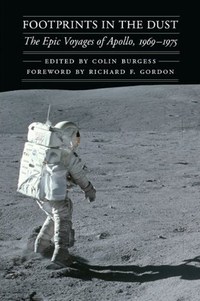|
|
Review: Footprints in the Dust
by Jeff Foust
Monday, September 20, 2010

Footprints in the Dust: The Epic Voyages of Apollo, 1969–1975
by Colin Burgess (ed.)
Univ. of Nebraska Press, 2010
hardcover, 520 pp., illus.
ISBN 978-0-8032-2665-4
US$34.95
“Considering one irrefutable fact—that there have been literally dozens of books written about the Apollo program—it took a mighty effort to come up with new angles and fresh material in approaching this well-known and certainly well-chronicled human endeavor,” Colin Burgess writes at the beginning of Footprints in the Dust. He is certainly right about the volume of works about the Apollo program: there is no shortage of general histories of the program, and over time most of the key players have been profiled in biographies or written their own memoirs. This has resulted in an increasing specialization of books about the era, including recent ones about the television cameras used on the Apollo missions (see “Review: Live TV From the Moon”, The Space Review, June 21, 2010) and the role of a little-known Australian tracking station (see “Review: Carnarvon and Apollo”, The Space Review, July 19, 2010).
So what are the “new angles and fresh material” that Burgess provides in Footprints in the Dust? The book is a collection of essays by what Burgess describes as “a cadre of spaceflight enthusiasts” that traces the history of human spaceflight from Apollo 11 through the end of Apollo, the Apollo-Soyuz Test Project (ASTP) in 1975. (Despite the subtitle, the book covers both the Apollo program and Soviet efforts during the same period.) Each mission from Apollo 11 through 17 gets its own chapter; Skylab is condensed into a single chapter, as is ASTP, while several essays examine the Soviet programs, including their failed lunar mission efforts, early Salyut space stations, and the Soyuz 11 accident.
| The book is a collection of essays by what Burgess describes as “a cadre of spaceflight enthusiasts” that traces the history of human spaceflight from Apollo 11 through the Apollo-Soyuz Test Project in 1975. |
The result is, in many cases, a rather conventional history of Apollo. The essays on most of the Apollo missions, particularly 12 and 14 through 17, are all fairly standard histories, with background about the astronauts and an account of the key events of the mission. The book wisely departs from this formula for the two best-known Apollo missions: Stephen Cass examines Apollo 13 from the vantage point of the flight controllers who worked to bring the wounded spacecraft home safely, while Rick Houston dispenses with a general review of Apollo 11 altogether, focusing more on how various people watched and remembered the mission, from a young boy who would later become an astronaut (Tom Jones) to a Vietnam POW who only indirectly found out about the landing weeks later. Similarly, the essay about ASTP is as much author Geoffrey Bowman’s tale of his journey from the UK to Florida to see the launch as it is about the mission itself.
Beyond that, there isn’t much in the way of new material in the book, although the essays about the Soviet program of that era are likely to be more enlightening than the Apollo essays simply because the typical reader is probably less familiar with the details about Soviet missions. That doesn’t mean that Footprints in the Dust is a bad book: it is, in fact, a good, general history of human spaceflight of that era. However, for those with more than a passing familiarity with those missions, the book won’t add much in the way of new insights about those missions or their broader historical context. It’s proof of Burgess’s statement in the introduction of just how well-chronicled this era in spaceflight truly is.
Jeff Foust (jeff@thespacereview.com) is the editor and publisher of The Space Review. He also operates the Spacetoday.net web site and the Space Politics and NewSpace Journal (formerly Personal Spaceflight) weblogs. Views and opinions expressed in this article are those of the author alone, and do not represent the official positions of any organization or company, including the Futron Corporation, the author’s employer.
|
|
